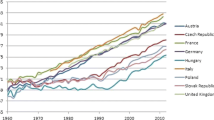Abstract
In overlapping generations models with endogenous fertility wherein the retired partake of consumption but do not contribute to production (through their labor), fertility has a positive and a negative externality. These can be internalized through a child allowance (or tax) or a linkage between pension benefits and the number of children. The prescription rest crucially on the assumption that no parents are better than others in raising their children and that fertility can be perfectly controlled. When either of these two assumptions are violated, the case for such policy recommendations are greatly weakened.
Similar content being viewed by others
References
Abel, A. (1987). Operative gift and bequest motives. American Economic Review, 77, 1037–1047.
Abio, G., Mathieu, G., & Patxot, C. (2004). On the optimality of PAYG pension systems in an endogenous fertility setting. Journal of Pension Finance, 3, 35–62.
Becker, G. S., & Barro, R. J. (1988). A reformulation of the economic theory of fertility. Quarterly Journal of Economics, 103, 1–25.
Bental, B. (1989). The old age security hypothesis and optimal population growth. Journal of Population Economics, 1, 285–301.
Cigno, A. (1993). Intergenerational transfers without altruism: Family, market and state. European Journal of Political Economy, 9, 505–518.
Cigno, A., & Luporini, A. (2003). Optimal policy with heterogeneous families, asymmetric information and stochastic fertility. Paper presented at CESifo Venice Summer Institute.
Cigno, A., Luporini, A., & Pettini, A. (2003). Transfers to families with children as a principal-agent problem. Journal of Public Economics, 87, 1165–1177.
Cremer, H., Gahvari, F., & Pestieau, P. (2003). Stochastic fertility, moral hazard, and the design of pay-as-you-go pension plans. Paper presented at CESifo Venice Summer Institute.
Cremer, H., Gahvari, F., & Pestieau, P. (2006). Pensions with endogenous and stochastic fertility. Journal of Public Economics, 90, 2303–2321.
Cremer, H., Gahvari, F., & Pestieau, P. (2008a). Pensions with heterogeneous agents and endogenous fertility. Journal of Population Economics, 21, 961–981.
Cremer, H., Gahvari, F., & Pestieau, P. (2008b). Education, fertility, and the pension system. Mimeo.
Dasgupta, P. (1969). On the concept of optimum population. Review of Economic Studies, 36, 295–318.
Dasgupta, P. (1995). The population problem: theory and evidence. Journal of Economic Literature, 33, 1879–1902.
Deardorff, A. V. (1976). The optimum growth rate for population: Comment. International Economic Review, 17, 510–515.
Diamond, P. (1965). National debt in a neoclassical growth model. American Economic Review, 55, 1126–1150.
Fenge, R., & Meier, V. (2005). Pensions fertility incentives. Canadian Journal of Economics, 38, 28–48.
Golosov, M., Jones, L. E., & Tertilit, M. (2007). Efficiency with endogenous population growth. Econometrica, 75, 1039–1071.
Kolmar, M. (1997). Intergenerational redistribution in a small open economy with endogenous fertility. Journal of Population Economics, 10, 335–356.
Meade, J. E. (1955). Trade and welfare. Oxford: Oxford University Press.
Michel, P., & Pestieau, P. (1993). Population growth and optimality. Journal of Population Economics, 6, 353–362.
Michel, P., & Wigniolle, B. (2007). On efficient child making. Economic Theory 31, 307–326.
Samuelson, P. A. (1958). An exact consumption-loan model of interest with or without the social contrivance of money. Journal of Political Economy, 66, 467–482.
Samuelson, P. A. (1975). The optimum growth rate for population. International Economic Review, 16, 531–538.
Sinn, H. W. (2004). The pay-as-you-go pension system as fertility insurance and an enforcement device. Journal of Public Economics, 88, 1335–1357.
Solow, R. M. (1956). A contribution to the theory of economic growth. Quarterly Journal of Economics, 71, 1–25.
van Groezen, B., Leers, T., & Meijdam, L. (2000). Family size, looming demographic changes and the efficiency of social security reform. CentER Working Paper no 2000–27, Tilburg.
van Groezen, B., Leers, T., & Meijdam, L. (2003). Social security and endogenous fertility: pensions and child allowances as Siamese twins. Journal of Public Economics, 87, 233–251.
Author information
Authors and Affiliations
Corresponding author
Additional information
This paper is based on a keynote speech delivered at the IIPF 64th Congress, Maastricht, Netherlands, August 22–25, 2008. I am grateful to the organizers for the opportunity they accorded me and to the participants and a referee of this Journal for their comments. I am particularly indebted to Helmuth Cremer and Pierre Pestieau who over the years have collaborated with me in studying many of the issues I discuss in this paper.
Rights and permissions
About this article
Cite this article
Gahvari, F. Pensions and fertility: in search of a link. Int Tax Public Finance 16, 418–442 (2009). https://doi.org/10.1007/s10797-009-9114-3
Received:
Accepted:
Published:
Issue Date:
DOI: https://doi.org/10.1007/s10797-009-9114-3
Keywords
- Pay-as-you-go
- Overlapping generations
- Endogenous fertility
- Externality of fertility
- Stochastic fertility
- Moral hazard
- Parents’ heterogeneity
- Adverse selection




